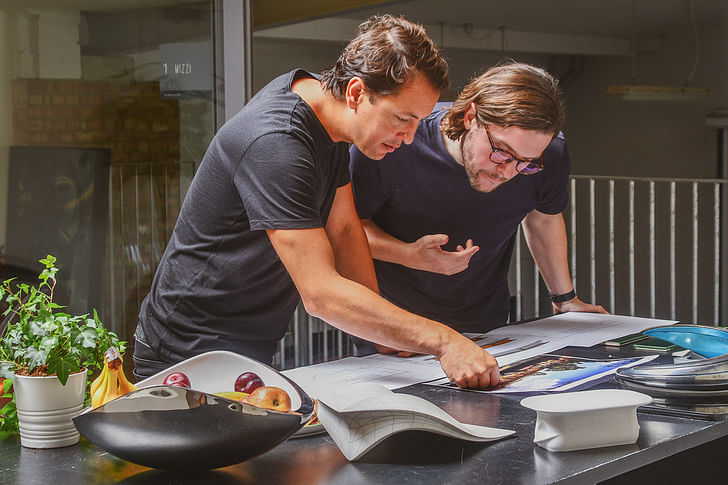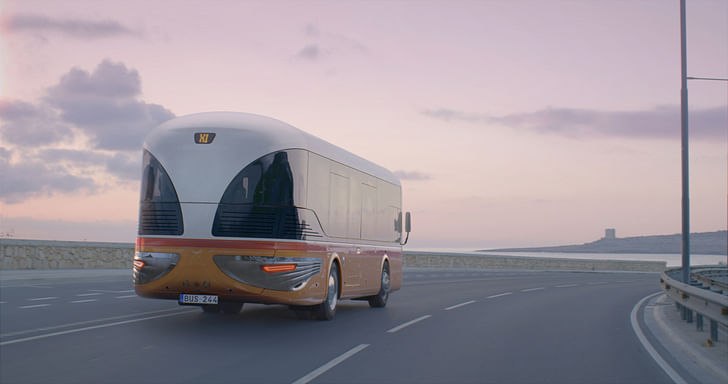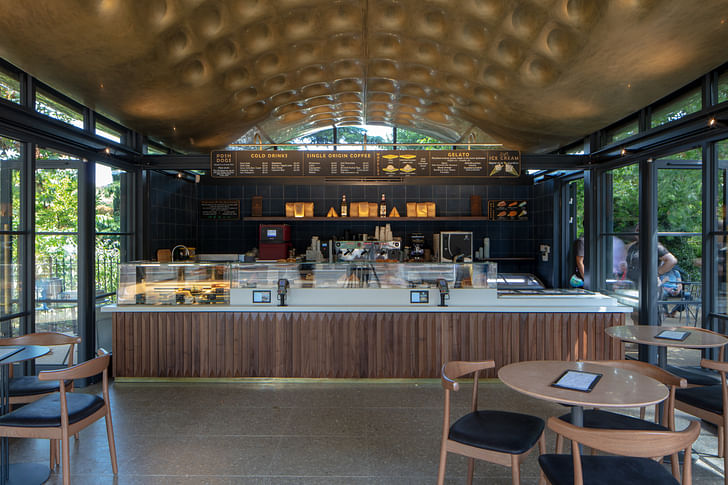

I met Jonathan Mizzi and the Mizzi Studio team in their West London studio back in the summer. The team were all busy working away on various exciting projects as I was shown around and there was a feeling of excitement in the air. Having just moved their studio (only upstairs mind), there was an abundance of interesting models, sketches and samples for me to explore.
Jonathan, born in Malta, started the practice in 2011 after an interesting and fruitful alignment of events. An extremely passionate individual, he talks with great enthusiasm about all their projects past and present but one in particular - the Malta Bus Reborn. These characterful, emblematic, buses were retired for failing to meet EU standards for carbon emissions in 2011 but have been brought back to life by Mizzi Studio. Initially started as a passion project it is now fully supported by the Maltese Ministry for Transport, Infrastructure and Capital Projects and is very quickly gaining speed. I found out more about the importance of this project, other work in London and Malta and studio life at Mizzi Studio.
Location?
West London and Malta
When did the practice start?
The practice started at the end of 2011. Before I started the practice I worked at Foster + Partners as a concept designer having studied architecture and film studies. I studied film because of an interest in futurism within science fiction and because of the lack of financial and technological restraints within the field. This education meant I met people like Jason Bruges Studio and Cinimad Studio and found it was an amazing way of doing architecture in the real life but within the fourth dimension. From there I started working with Snog, the Frozen Yoghurt chain in Covent Garden and then on the Kings Road. I live in Westbourne Park just off Portobello Road and there was a frozen yoghurt store opening there - I just walked in and struck up a conversation. The owner buys frozen yogurt and ice cream machines from an Italian company that caters to all of the Royal Parks and happened to mention there was a bid for the extension of the Pheasantry Welcome Centre. We entered and won - in that meeting all of those links joined up. That is how it all got started and we have been head down going ever since and never looked back!
How many staff are you?
We are now 7 in London and 3 in Malta (which opened last year).

What is your Company ethos?
We have a very particular focused approach inspired by the natural world and natural processes but we bring them to life with a fusion of computer aided design. In regards to our values we want to continue working in the public realm, we want to do projects that have a significant and environmental impact.
Currently what projects are you working on?
The Malta Bus Reborn project, is a self initiated project we started seven years ago. It was started at the same time as the Heatherwick Studio: Designing The Extraordinary at the V&A, which had a cutout of the Routemaster on display. What I love about London is how it is constantly reinventing itself and progressing forward whilst staying true to its roots and heritage. In Malta we lost our buses, they were even more unique, they were all customised because they were privately owned. After WWII they started building on the old chassis off the trucks, that’s how it all started, each one had its own colour and was covered with imagery and cultural references of the time including Elvis Presley and local saints. The result was a great symbol of our craftsmanship, developed on art deco principles, very bold and dynamic but sadly we lost them.
We have a very particular focused approach inspired by the natural world and natural processes but we bring them to life with a fusion of computer aided design.

We started working on our idea about seven years ago, it was all pro-bono but we really wanted to do it so went for it. I have always had a love of vehicle design and always found a way to incorporate it while studying architecture. Working on this project was a big part of us planting our roots in different sectors. The biggest challenge was to capture the essence and key genetics of them all, as there were over four hundred in total. I am pleased now that it has taken so long as now the electric capabilities are up to scratch and the new vehicles can be emission free. It is culturally and environmentally impactful, exactly the kind of project we want to be working on. We launched an exhibition in Malta in October to share the project. We now have over ten supporters including the Arts Council in Malta and finally the Ministry of Transport.

The Serpentine Coffee House is a part of the ongoing commission for the Royal Parks. The original brief was to create a family fleet of kiosks (nine in total and one coffee house) that would represent the Royal Parks values as a sustainability leader. Also though, the client wanted the kiosks to enrich the lives of Londoners so it was great to work on a project, though small in scale, was very important from an identity perspective and a very important responsibility for us as way-finder ambassadors.
They asked us if we could create a cafe that could house people and reflect the architectural merit of its neighbours (The Serpentine Sackler and the Zaha Extension). We set out to create a creature that sort of jumped out from the Serpentine lake which evolved along the way to a smiling sting ray, a wonderful greeting on entering the park. We wanted to create something welcoming but that is also built upon classical architectural archetypes that you find in Japanese Teahouses and Pagodas, a classic dome that morphs into these architectural forms that people have seen before.
It is made and milled all out of one piece and then has a structure of carbon and glass fibre all finished by hand - you can see the human marks upon it. I think the result is a very progressive, futuristic, frozen moment of flight from a creature. But, that human element and the brassy warm earthy natural colours from brass gives it that sense of familiarity. Inside there is this underbelly of dimples that glow as you walk in, as if you have been swallowed by Jonah the Whale.
And we have one more kiosk left to install. The brass kiosk is the really exciting one, right in front of Buckingham Palace in St. James Park at the horseshoes.

Natural materials, copper, brass, timber they are always at the back of our mind but context is such a driving force for us and we utilise digital techniques to understand and inform this process
Often you use craft techniques that are then developed and enhanced by digital techniques I wondered if there is a process behind this?
We start with the function of the building or the function we need to serve. What are the site’s contextual parameters? At this stage we would start to think how to make it but we wouldn't let that dictate the process. Then we start to try and figure out, ‘how are we going to deliver this?’. Natural materials such as copper, brass, timber are always at the back of our mind but context is such a driving force for us and we utilise digital techniques to understand and inform this process. The project we did in Westfield is a very good example, we used an eighteenth century technique and brought it into the twenty first century. The design was broken down - unfolded in a computer environment then copper sheet metal was machine cut using lasers, then bent back by hand with sixteen hundred rivets sticking it all together.

Do you find the digital techniques afford you more opportunity?
Yes! We are working on a small scale in these instances but the fact that everything is so automated by the machine means that everything is much more affordable than you would think. It allows you to create a new form of expression that hasn’t really been seen before.
When did you set up the office in Malta and what was the reason behind this?
It is was set up a year ago. I always had the intention of setting up there as I am Maltese, it provides a connection to home for me. Additionally though, work was coming for us from Malta, there were a lot of opportunities, especially larger projects which are trickier to get in London.

Do you have a favourite part of the studio?
The table tennis table!
How much do you socialise together as a team?
Loads! We of course go to the pub together, events, Christmas party and now trips to Malta!
Do you have an architect or architectural style you look up to?
My biggest influences architecturally would be Zaha Hadid, Thomas Heatherwick, Renzo Piano and Gaudi. But then also designers and artists like Marc Newson and Ross Lovegrove and also science fiction films. And lastly nature, always nature.

What is your favourite building in London?
Probably The Gherkin (30 St Mary Axe Street). To me it optimises the height of height tech architecture in the early 2000s. I love the fact that it has been built by the best British architect there is [Norman Foster] and that it is in the capital. I just love the eclectic nature that London architecture offers.
What is your favourite building you have designed?
It is impossible to say! I can’t choose. Prestige wise, it has to be the Royal Parks, as a building the Serpentine Coffee House for being the most refined, Westfield for being the most challenging. The Malta Buses for their personal importance to me and Malta - if this does actually go through this will be the best project we have ever done because it is evidence that you can start something and make it happen yourself.
Ellen Hancock studied Fine Art and History of Art at The University of Leeds and Sculpture at Mimar Sinan Fine Arts University in Istanbul.Now based in London she has a keen interest in travel, literature, interactive art and social architecture.
No Comments
Block this user
Are you sure you want to block this user and hide all related comments throughout the site?
Archinect
This is your first comment on Archinect. Your comment will be visible once approved.